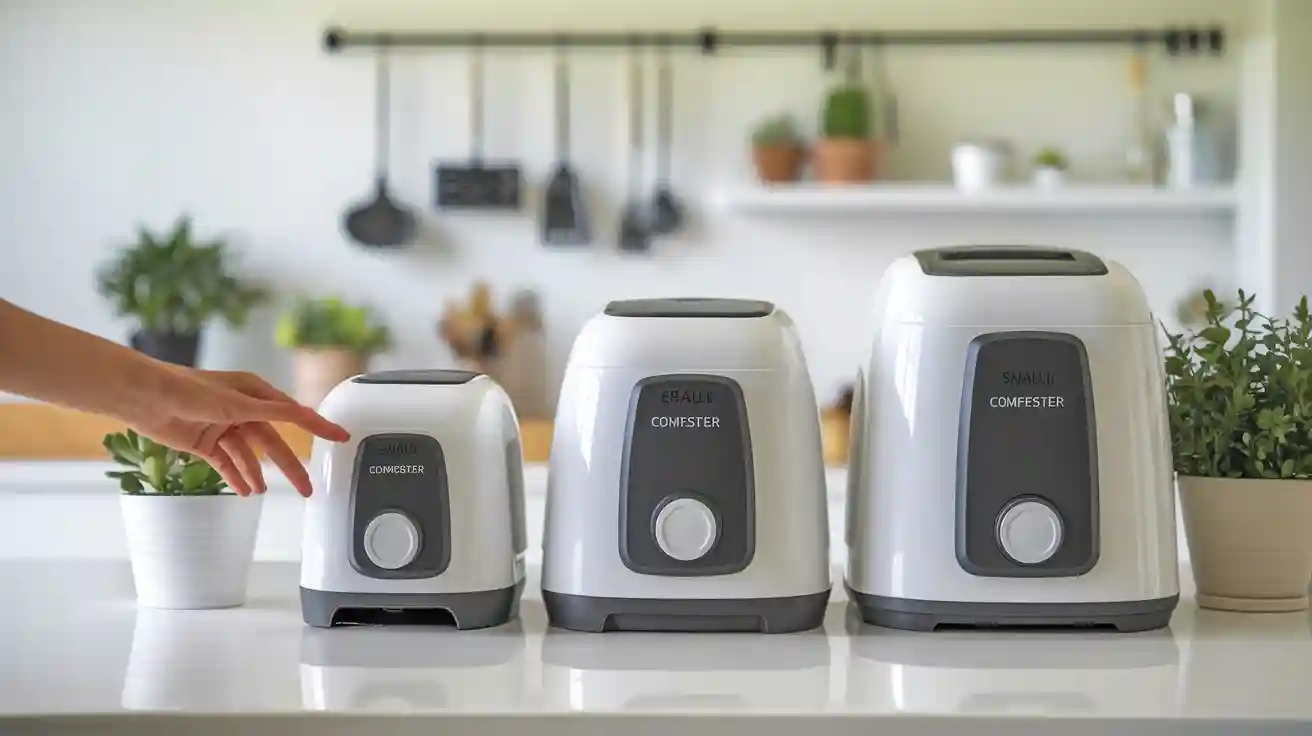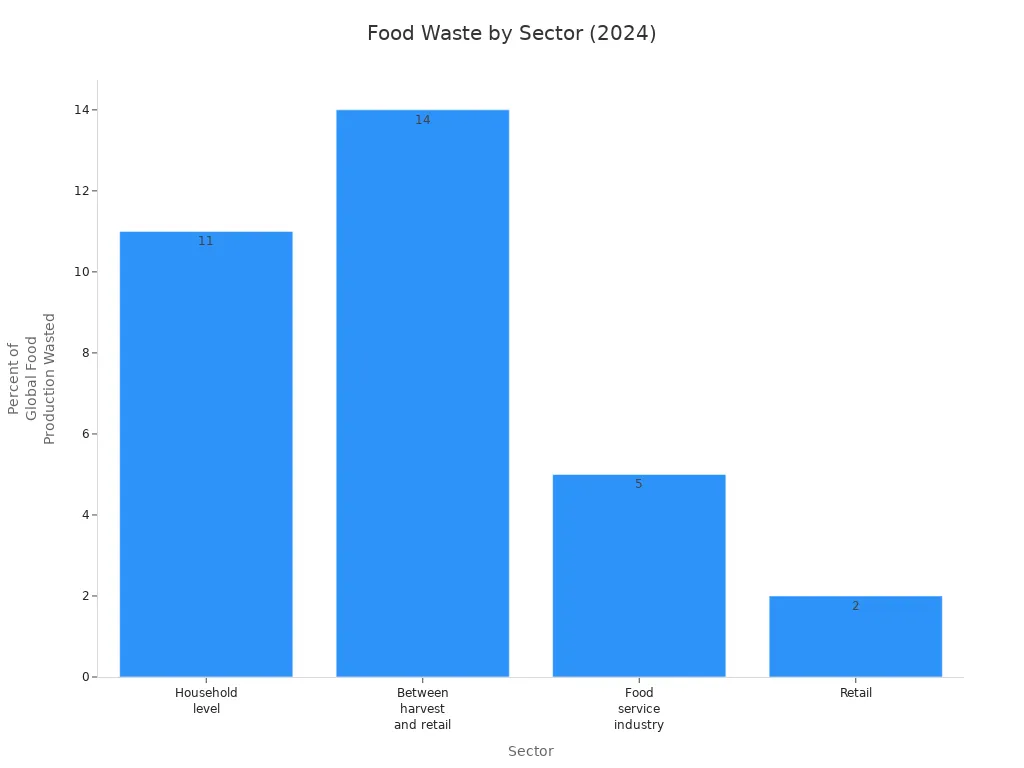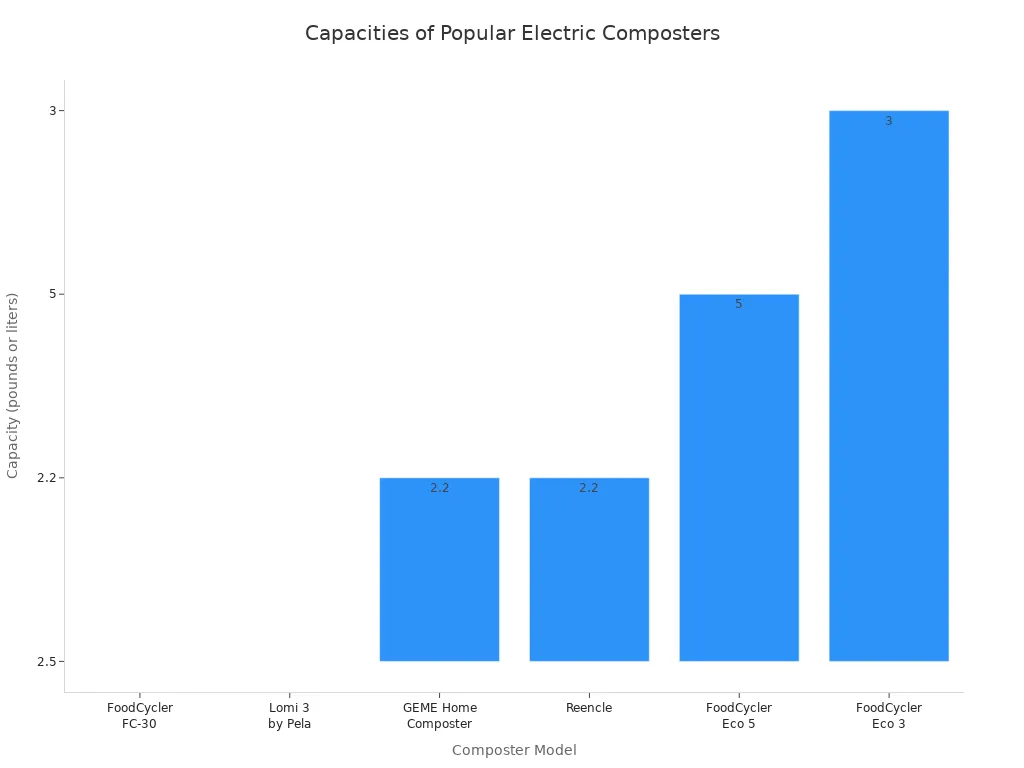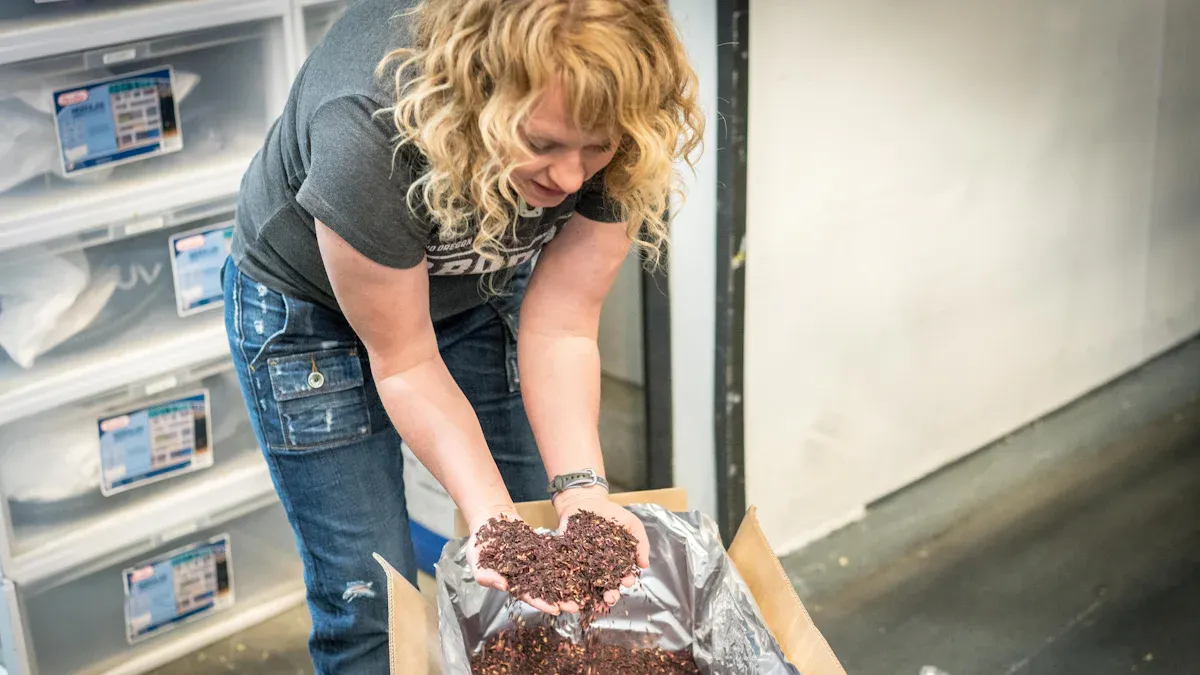
Choosing the right indoor electric composter starts with understanding how much food waste your household creates. Did you know households waste about 11% of global food production? Check out the chart below to see how food waste compares across sectors. The right size boosts kitchen composting efficiency and adds convenience.
| Statistic Description | Value/Percentage |
|---|---|
| Portion of total global food production wasted at household level | 11% |
| Total global food production wasted | About one-third (~33%) |
| Food lost between harvest and retail | Approximately 14% |
| Food wasted in households | 11% |
| Food wasted in food service industry | 5% |
| Food wasted in retail | 2% |
| Global food waste volume | Approximately 1.3 billion tonnes annually |
| Economic cost of global food waste | Around $1 trillion annually |
| Contribution of food waste to global greenhouse gas emissions | Approximately 8% |
| Energy usage attributed to food loss and waste | 38% of total energy in global food system |

Indoor Electric Composter: Choosing the Right Size
Assessing Your Household’s Food Waste
Before you pick an indoor electric composter, you need to know how much food waste your household creates. Every family is different. Some people cook every day, while others eat out more often. You might have picky eaters or kids who change their minds about dinner. These habits all affect the amount of kitchen scraps you toss out.
You can track your food waste in a few ways. Try keeping a daily diary of what you throw away. You can also use a kitchen scale to weigh your scraps each day. Some people use mobile apps or Bluetooth scales to make this easier. If you want a quick estimate, write down what you toss for a week and add it up. This helps you see patterns, like if you waste more on weekends or after grocery shopping.
Here’s a table to help you think about what affects your food waste:
| Household Type / Factor | Food Waste Generation Characteristics |
|---|---|
| Households with young and middle-aged children | Highest food waste; kids can be picky and plans change often. |
| Households with adult children | Less waste; eating habits are less predictable. |
| Single-parent families | Lower food waste compared to families with young kids. |
| Larger families | More waste because you buy and cook more food. |
| Older household heads | Less food waste; they often plan meals better. |
| Shopping habits | Buying at big stores can lead to more waste. Using a shopping list helps cut down on waste. |
| Types of food wasted | Most waste comes from fruits, veggies, and bread. Animal products are wasted less. |
Tip: Try using both a diary and a kitchen scale for a week. You’ll get a better picture of your real food waste. This helps you choose the right indoor electric composter size and supports a sustainable lifestyle.
Why Size Impacts Kitchen Composting Results
The size of your indoor electric composter matters more than you might think. If you pick a bin that’s too small, you’ll need to empty it all the time. This can get annoying and may slow down the composting process. When the bin is too full, scraps don’t break down as well. You might notice more smells or even see mold.
On the other hand, a composter that’s too big can also cause problems. It might take up too much space in your kitchen. If you don’t fill it enough, the compost may not heat up properly. This slows down the process and can lead to bad odors. Composting works best when the pile reaches a certain size. This helps it stay warm and lets good microbes do their job.
Here’s a quick look at what to consider when picking the right size:
| Factor | Explanation | Example Product/Note |
|---|---|---|
| Capacity | Match the bin size to your cooking habits and family size. | 1.75 gallon composter is good for busy kitchens. |
| Available Space | Make sure the composter fits your kitchen or apartment. | Smaller units work well for singles or couples. |
| Convenience | Look for easy-to-use features like soft-close lids and simple cleaning. | Soft-close lids help control odor. |
| Maintenance | Think about how easy it is to clean and if you need liners. | Some bins are not made for liners. |
| Material Quality | Durable and heat-resistant bins last longer and work better. | Smooth interiors are easier to clean. |
If you match your composter size to your waste volume, you’ll see the benefits right away. You’ll have fewer smells, faster composting, and less mess. This makes kitchen composting easier and more sustainable. You’ll also feel good knowing you’re helping the planet by reducing waste and supporting a sustainable home.
Note: The right indoor electric composter can turn your kitchen scraps into rich compost without hassle. You get the benefits of less trash, better odor control, and a cleaner kitchen.
Estimating Food Waste for Kitchen Compost Bins
Tracking Daily and Weekly Kitchen Scraps
You might wonder how much kitchen waste you actually create each week. Start by keeping a small notebook or using your phone to jot down every bit of kitchen waste you toss. This includes fruit peels, veggie scraps, coffee grounds, and even eggshells. If you want to make things easier, try using apps like CozZo, Fridgely, or NoWaste. These apps help you track what you throw away and even remind you when food is about to expire. Some apps, like Olio, let you share extra food with neighbors, which helps reduce kitchen waste before it even reaches your kitchen compost bins.
Here’s a quick look at some helpful tools:
| App Name | Key Features | Benefit |
|---|---|---|
| CozZo | Tracks inventory, expiry dates, meal planning | Cuts kitchen waste by up to 70% |
| Fridgely | Expiry reminders, recipe suggestions | Less forgotten food |
| Olio | Food sharing with neighbors | Less waste, more sharing |
Tip: Tracking your kitchen waste for just one week gives you a clear picture of what goes into your kitchen compost bins.
Calculating Average Waste Volume
Once you have your notes or app data, you can estimate your average kitchen waste. Most American households toss about 3 to 8.7 pounds of kitchen waste each week, depending on family size. Smaller households often waste more per person, while bigger families waste less per person. To get a good estimate, count everyone in your home and look at your weekly kitchen waste total. If you want to cut down on waste, try using recipes that use up leftovers or plan meals ahead.
Here’s a simple way to estimate your kitchen waste:
- Count the number of people in your home.
- Track your kitchen waste for a week.
- Divide the total waste by the number of people.
- Use this number to choose the right kitchen compost bins for your needs.
By tracking and calculating, you make composting kitchen waste easier and more effective. You also take a big step toward transforming kitchen food waste into something useful for your plants and garden.
Matching Waste Volume to Indoor Electric Composter Capacity
Understanding Composter Size Options
When you look for kitchen compost bins, you’ll notice a range of sizes and features. Some indoor compost buckets are small and fit right on your counter. Others are bigger and need more space. For example, the Vitamix FoodCycler holds about 2.5 liters. It’s compact, about the size of a bread box, and works well in small kitchens. The Lomi Composter is a bit larger, holding around 3 liters, and has a modern look. Both fit on most kitchen counters, but the Vitamix is easier to tuck into tight spots. If you want more capacity, the Mill Kitchen Bin stands tall at 26.8 inches and stores kitchen waste for longer before you need to empty it.
You should also check the features each model offers. Some have soft-close lids, while others use special filters to control odors. Many indoor compost buckets now come with digital displays or app connections. These features make composting kitchen waste easier and more convenient.
Capacity Chart: Household Size vs. Composter Size
Choosing the best indoor compost buckets means matching your kitchen waste to the right bin. Here’s a quick chart to help you compare popular models and their features:
| Model | Capacity (liters) | Height (inches) | Features | Suitable For |
|---|---|---|---|---|
| Vitamix FoodCycler | ~2.5 | ~12 | Compact, odor filter, easy clean | Singles, small kitchens |
| Lomi Composter | ~3 | ~12 | Modern design, app, filter | Couples, small families |
| Reencle Prime | ~2.2/day | 18 | Microbe tech, quiet, filter | Families, floor/counter use |
| Mill Kitchen Bin | Largest | 26.8 | Stores more, monthly emptying | Large families, shared homes |

If you create a lot of kitchen waste, pick a larger bin with more features. For less kitchen waste, a compact model works best. Always check if the indoor compost buckets fit your space and meet your needs.
Tip: Think about how often you cook and how much kitchen waste you toss each week. The right size and features will make composting easy and mess-free.
Kitchen Composting and Available Space

Measuring Your Kitchen or Home Area
Before you pick a composter, take a good look at your kitchen or home area. Grab a tape measure and check the height under your cabinets. Many countertop compost bins stand between 10 and 14 inches tall. Some might be too tall to fit under your cabinets, so you may need to place them on a freestanding counter or even on the floor. Think about where you want your composter to go. You want it close to where you cook, so you can drop scraps in quickly. Good placement helps with air circulation, which keeps smells down and helps your compost break down faster. If you have a small kitchen, countertop compost bins are a smart choice. They save space and keep your kitchen tidy.
Compact vs. Larger Kitchen Compost Bins
Choosing between compact and larger countertop compost bins depends on your space and how much waste you make. Compact bins fit well in apartments or small kitchens. They protect your compost from weather and are easy to use indoors. Some high-tech countertop compost bins speed up composting, but they need electricity and can cost more. You might find that compact bins fill up fast if you cook a lot. This means you’ll empty them more often, which can add to your maintenance routine.
Larger bins hold more waste and often have better temperature control. This helps with faster decomposition and better circulation. They work best if you have more floor space. Larger bins can also help with the importance of air circulation, which keeps your compost healthy. But, they need more maintenance and can attract pests if you don’t manage them well.
Here’s a quick table to help you compare:
| Advantages of Compact Kitchen Compost Bins | Disadvantages of Compact Kitchen Compost Bins |
|---|---|
| Suitable for urban areas and small spaces | May be too small for the volume of waste generated |
| Protects compost from weather changes | Slow to produce usable compost |
| High-tech options speed up composting | High-tech options require energy and are made of plastic |
| Convenient for indoor use | Upfront investment cost can be high |
| Advantages of Larger Compost Bins | Disadvantages of Larger Compost Bins |
|---|---|
| Larger capacity allows for more waste | Requires more space, less suitable for small urban homes |
| Better temperature control and faster decomposition | Can attract pests if not properly managed |
| Protects compost from weather and odors | Higher purchase cost and need for maintenance |
| Improves hygiene and reduces pest issues compared to open piles | Poor design or maintenance can cause odors and vermin problems |
When you choose between countertop compost bins, think about your kitchen’s size, your cooking habits, and how much time you want to spend on maintenance. Good circulation in your bin helps keep things fresh and makes composting easier.
Making the Most of Your Kitchen Compost Bin: Usage Frequency and Lifestyle
Daily vs. Weekly Composting Habits
How often you use your indoor electric composter can change what size works best for you. If you compost every day, you usually deal with smaller batches of food scraps. Most automatic composters handle about 2 to 5 pounds per cycle. You might run your composter two to four times a week, which means you can pick a smaller unit. Daily composting keeps your kitchen cleaner and helps you avoid smells. If you prefer to collect scraps all week and compost once, you need a larger bin. Weekly composting means more waste at once, so your composter must hold more. Remember, composting shrinks your scraps by up to 90%. This makes it easier to manage, but your habits still matter when choosing the right size. By matching your routine, you’re making the most of your kitchen compost bin.
Convenience for Busy Households
Busy families want kitchen composting to be simple and quick. Many people run their electric composter every night, letting it work while they sleep. Some models, like the Mill, only need emptying once a month. That saves you time and effort. You’ll find features that make life easier, such as:
- Compact designs that fit on your counter
- Odor control with carbon filters
- Fast cycles that finish in just a few hours
- Low noise so you can run it anytime
- Easy cleaning and rare filter changes
Check out this table to see how electric composters compare to traditional ones:
| Feature | Electric Composter | Traditional Composting |
|---|---|---|
| Processing Time | 3–12 hours | Weeks to months |
| Odor Control | Sealed, filtered | Needs active care |
| Maintenance | Minimal | Frequent turning |
| Space Needed | Small, indoor | Outdoor space |
When you choose the right features, you’re making the most of your kitchen compost bin and adding real convenience to your routine.
Common Household Scenarios: Size Recommendations
Single Person
If you live alone, you probably don’t make much food waste. A small indoor electric composter works best for you. Look for a model that holds about 2 to 3 liters. These compact bins fit right on your kitchen counter. You can run them every few days. This keeps your kitchen tidy and makes composting easy. You won’t need to empty the bin too often.
Couple
For two people, you might cook more meals at home. Your food scraps will add up a bit faster. Choose a composter with a 3 to 5-liter capacity. This size gives you enough space for a few days’ worth of kitchen waste. Many couples like countertop models with odor filters. These features help keep your kitchen smelling fresh.
Family of 3-4
A family of three or four creates more food waste each week. You need a composter that can handle bigger loads. Many experts suggest a bin that matches the waste from a typical household this size. Outdoor bins that measure about 3 feet on each side work well for traditional composting. For indoor electric composters, pick a model with a larger capacity or one that you can run daily. Some families use two bins or a system that lets you compost in batches. This setup keeps up with your busy kitchen and helps you manage waste without hassle.
Large Family or Shared Households
Big families or shared homes need the most composting power. You might want a composter with the largest capacity available. Some models hold over 10 liters or let you empty them just once a month. If your household cooks a lot, look for features like fast cycles and strong odor control. You can also use two composters at once. This way, you never run out of space for your kitchen scraps.
Quick Checklist for Indoor Electric Composter Selection
Essential Questions Before Buying
Before you buy an indoor electric composter, you want to make sure it fits your needs and supports a sustainable lifestyle. Here are some key questions to ask yourself:
- Can you use the composter easily, or does it have complicated steps?
- What types of food waste can you put inside? Some models handle meat, bones, and dairy, while others do not.
- Does the machine make a lot of noise or create strong odors during use?
- How long does each composting cycle take? Will this work with your daily routine?
- What can you do with the compost output? Can you use it as fertilizer for your plants or garden?
- Is the composter easy to store when you are not using it?
- Does the size match your household and how often you cook?
- Will the composter help you reduce waste and make composting simpler than traditional methods?
- Is it compact enough to fit on your kitchen counter?
- Does it suit people who want less mess or have no outdoor composting options?
- Are there features to look for in a kitchen compost bin that make it more convenient, like odor filters or fast cycles?
Tip: Look for top countertop compost bins with strong circulation and odor control. These features bring big benefits, like less smell and faster composting.
Choosing a sustainable compost bin means you get the benefits of less trash, cleaner air, and a greener home. You also enjoy the benefits of easy maintenance and less hassle. Regular cleaning and maintenance tips help you keep your composter working well. Maintaining your kitchen compost bin is simple if you follow the instructions and keep up with cleaning. Good circulation and smart features make a sustainable kitchen routine easy. You get the benefits of an eco-friendly practice that fits your busy life.
Tip: The benefits of a sustainable composter go beyond your kitchen. You help the planet and enjoy a cleaner, greener home.
Choosing the right indoor electric composter is easy when you follow these steps:
- Track your food waste.
- Measure your space.
- Match your needs to the right bin size.
Use the checklist above to shop with confidence. Start today and turn your kitchen scraps into something great!
FAQ
How often should you empty your indoor electric composter?
You should empty your composter every few days or when it’s full. Some models let you wait up to a month. Check your bin’s size and your food waste.
Can you put meat and dairy in an indoor electric composter?
Most electric composters handle meat and dairy. Always check your model’s manual first. Some bins work best with only fruit, veggies, and bread.
What do you do with the finished compost?
You can mix the finished compost into your houseplants, garden soil, or even sprinkle it on your lawn. It helps your plants grow strong and healthy.


